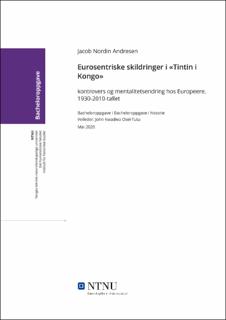| dc.contributor.advisor | Osei-Tutu, John Kwadwo | |
| dc.contributor.author | Andresen, Jacob Nordin | |
| dc.date.accessioned | 2021-09-13T16:00:30Z | |
| dc.date.available | 2021-09-13T16:00:30Z | |
| dc.date.issued | 2020 | |
| dc.identifier | no.ntnu:inspera:57493347:22999256 | |
| dc.identifier.uri | https://hdl.handle.net/11250/2775473 | |
| dc.description.abstract | Denne bacheloroppgaven skal granske utviklingen av europeisk mentalitet om afrikanere, og hvordan den har endret seg fra 1930-2012. Den empiriske analysen blir gjort gjennom å se endringene av innholdet i tegneserien «Tintin i Kongo», samt kontroverser som har omhandlet verket. Når tegneserien først ble skrevet i 1930 var den kun basert på allmennaksepterte, europeiske forestillinger om Afrika, som var strekt preget av europeisk overlegenhetstankegang. Ettersom Afrika ble mer selvstendig og synet på imperialisme endret seg i etterkant av 2. verdenskrig ble det gjort endringer for å luke ut de koloniale referansene. På 1970-tallet måtte en scene der Tintin sprenger et nesehorn med dynamitt bli endret på for at tegneserien skulle bli publisert i Skandinavia. På 2000- og 2010-tallet oppstod en rekke kontroversen rundt «Tintin i Kongo» som ble igangsatt av forsøk på å stoppe salg og utlån av tegneserien. «Tintin i Kongo» ble blant annet saksøkt, men vant i retten. Det jeg har funnet ut er at det har vært en markant endring i europeisk mentalitet fra 1930 til 2012, og at endringene av og kontroversene rundt «Tintin i Kongo» speiler europeisk mentalitetsendring om afrikanere sett i et historiografisk perspektiv godt. Tegneserien funker godt som både som historisk kilde for å forstå tidligere konsensus om Afrika, og situasjonene rundt (samt endringene av innholdet i) «Tintin i Kongo» er en god kilde for å se og forstå hvorfor og hvordan europeisk mentalitet om Afrika har endret seg. | |
| dc.description.abstract | This bachelor thesis will examine the evolution of the European mentality about Africans and how it has changed from 1930-2012. The empirical analysis is done by looking at the changes in the content of the comic "Tintin in Congo", as well as controversies that have covered the work. When the comic was first written in 1930, it was based only on widely accepted European notions of Africa, which were marked by European superiority. As Africa became more independent and the view of imperialism changed after the Second World War, changes were made to remove the colonial references. In the 1970s, a scene where Tintin blows up a rhinoceros with dynamite had to be changed in order for the cartoon to be published in Scandinavia. In the 2000s and 2010s, a lot of controversy arose about "Tintin in Congo" which was initiated by attempts to stop the sale and lending of the cartoon. "Tintin in the Congo" was sued, but won in court. What I have found is that there has been a significant change in European mentality from 1930 to 2012, and that the changes and controversies surrounding "Tintin in the Congo" reflect European change in mentality about Africans seen from a historiographical perspective. The cartoon works well as both a historical source for understanding past consensus on Africa, and the situations around (as well as changes in the content of) "Tintin in the Congo" are a good source to understand why and how European mentality about Africa has changed. | |
| dc.language | | |
| dc.publisher | NTNU | |
| dc.title | Eurosentriske skildringer i «Tintin i Kongo» | |
| dc.type | Bachelor thesis | |
